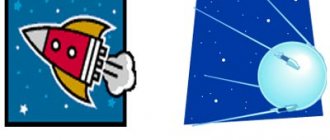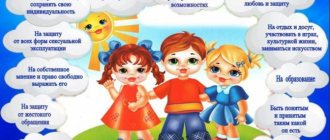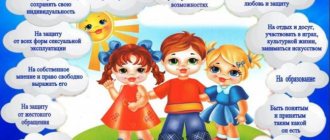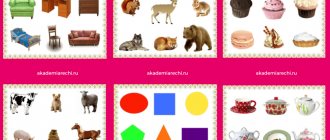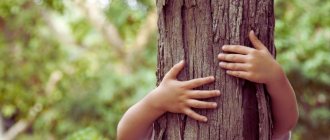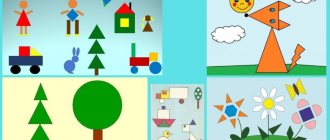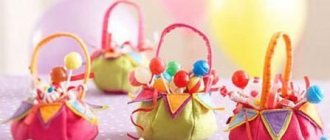MAGAZINE Preschooler.RF
Didactic game “The House We Live In” Author: Zvereva Olesya Borisovna MBDOU kindergarten “Childhood”, combined type kindergarten No. 160, Nizhny Tagil. Designed for independent play of children and joint organization of educational activities of pupils with parents or teachers. Goal: Creating conditions for optimizing the process of sensory development of younger preschoolers by ensuring the accumulation of ideas about the color, shape and size of objects. Progress of the game: Stage 1: v The first floor is green. To get to the game, you need to unfasten the carabiner and zipper. Behind the green doors the child finds the game “Flower of Seven Flowers.” Each petal is fastened with a button. Behind the petals is a pyramid. Every detail of the pyramid is attached with Velcro. Objectives of the 1st stage of the game: 1. Develop tactile sensitivity of the fingers, fine motor skills of the fingers when fastening, unfastening, and applying; 2. Introduce the shape of an object, color, size; sequence of objects; 3. Learn to group by size; 4. Introduce various materials (different types of fabric).Stage 2:
Progress of the game:
v The second floor is red. In order to find a game, “We are going, going, going...” The child needs to unfasten two hooks and unlace the sashes. A truck opens in front of the child, in the back of which lie tactile geometric shapes. The cabin door closes with a hook, and behind the transparent window the child can place his or her photo or a picture of the driver. Traffic lights on linden trees. Sun on the button.
Objectives of stage 2 of the game:
1. Develop tactile sensitivity of the fingers, fine motor skills of the fingers when fastening, unfastening, and applying;
2. Introduce the shape of an object, color, size; sequence of objects;
3. Promote memorization of geometric shapes;
4. Develop imagination.
Stage 3:
Progress of the game:
v The third floor is blue. Fastened with a buckle, two buttons of different sizes and a button. Behind the doors is the game “Draw a Path.” The child uses a cord to connect rings of the same color with a picture related to this character.
Objectives of the 3rd stage of the game:
1. Develop tactile sensitivity of the fingers, fine motor skills of the fingers when fastening, unfastening, threading;
2. Develop logic and imagination.
Result: children develop fine motor skills of their fingers, and their fingers become more sensitive. Children know the shape of objects, color, size, sequence of objects, and know how to group objects. They know geometric shapes. They gain self-service skills (they know how to button and unfasten buttons, buttons, zippers). Logic and imagination become more developed.
| Next > |
Thematic selection of games and exercises, theme: “Home”
Thematic selection of games and exercises, theme: “Home”
Equipment:
Background picture “sky and earth”, figures of the sun, clouds, houses, flowers. Pictures depicting one and two houses, cards with numbers “1” and “2”. Background picture with an image of a crane, details in the form of blocks with a door and windows, a roof; glue sticks Paired pictures depicting houses. One-, two- and three-story houses built from a designer. Wooden spatulas. Multi-colored clothespins. Large building material, various attributes for the obstacle course. Picture-diagram of a house, details of these houses are made of colored cardboard. Drawing of a house with empty windows, yellow finger paint. A sheet of paper with two vertical lines drawn, plasticine. Educational game “Pick up the key to the lock.” A picture depicting three houses. Figures of giraffes, hippos and snakes. Audio recordings: “There is a house made of logs in the forest,” “I want to build a house.”
Content:
Finger game “New House”
Knock-knock-knock, knock-knock-knock! Take the hammer my friend! (Children hit fist on fist, alternating hands)
We will build a new house, (There is a window in the house. The thumbs are folded into a shelf, the rest are connected by a “roof”)
There is another one, higher. (Raise your hands up without changing the position of your fingers)
There is a pipe up on the roof. (Raises a clenched fist with the index finger extended upward)
The house is ready, we invite guests: Come quickly! (Show an inviting hand gesture)
Didactic game "House on the Mountain".
— The picture shows the sky and the earth.
Show me the sky. Show me the land. Pick up the house and attach it to the picture. In which part of the picture did you attach the house, to the sky or to the ground? Why? Let's put the sun and clouds in the picture. Where will you put the sun and clouds? On sky. Let beautiful flowers grow around our house. Where will you place the flowers? Around the house, on the grass.
How many houses do you have? One house. How many flowers? Many colors. How many suns? One sunshine. How many clouds? Two clouds.
Didactic game “How many houses?”
Count the houses in the picture and label them with numbers.
Application "Let's build a house."
The crane is taller than everyone else! He put a roof on the house. He also built the walls! That's it - the house is built!
Let's build a house. Lay out the first floor with a door. Lay out the second floor with windows on top. Place the roof even higher. It turned out to be a new house, how many doors (windows, floors) are there in it?
Paired pictures “Houses”.
- The pictures are lost. Find the exact same picture. (Children find exactly the same picture as theirs. The pictures are laid out on the carpet, and their pairs are distributed to the children).
Didactic exercise “High-low house”.
— There are houses in front of you. Let's count them. One two Three. Take a closer look, which of the houses is the tallest? Which one is the lowest? Count how many floors are there in the tallest house? How many floors are there in the lowest house? How many floors are there in an average house?
“Now I’ll cover all three houses with handkerchiefs, and you can guess where which house is hidden.” Under which scarf is the lowest house hidden? Highest? Average house?
Game with clothespins “Beautiful fence”
- Here are the planks, and here are the clothespins. Let's make a beautiful fence out of them for our houses.
Dynamic pause “At a construction site”
— We need to transport building material to the construction site. Can you help?
Children carry large building materials from one place to another, overcoming obstacles (stumps, puddles, etc.)
Construction "Lay out the house"
— The pictures show a diagram of a house that you will lay out and build yourself. Take the parts and place them in the right place on the diagram. Where the triangular roof is drawn, attach a colored triangle there; where the square window is located, attach a square.
(In the archive with the activity there are pictures with a similar task for the youngest children, there are one-story houses).
Exercise “What sounds do you hear at home?”
How does the kettle whistle? Ssss. How does the alarm clock ring? Z-z-z. How does water drip from a tap? Drip-drip-drip. How does dad work with a drill? F-f-f. How does the vacuum cleaner hum? Oooh. How do guests knock on the door? Knock-Knock.
Finger painting “Light the lights in the windows of the houses”
— Evening came, it became dark. You need to turn on the light and then the windows in your houses will light up with bright light. Dip your finger into the yellow paint and place it on the window.
(For the little ones there is a simplified picture in the archive).
Musical finger game “There is a house made of logs in the forest.”
(Conducted with audio recording).
Manual labor "Staircase".
— We need to fix the old staircase, the steps of which are broken. Take plasticine. Roll out two thin sausages, place them next to each other and attach steps (matches) to them.
We walk up the stairs Let's count all the steps: One, two, three, four, five - It's very fun to count! One, two, three, four, five - It's very fun to walk!
Didactic game “Pick up the key to the lock”
Children match keys to locks of the same color and open them.
A house on a meadow, All doors are locked. We'll pick up all the keys and unlock the hut.
Didactic game “Whose house?”
The picture shows three houses - high, lower and low. Children are given three figures - a giraffe, a hippopotamus and a snake.
- Children, think about who lives in which house? What house does the giraffe live in? In the highest house. Why did you decide so? What house does the hippopotamus live in? The hippopotamus lives in the lower house. Why? Now think and tell me - which house is suitable for a snake? The lowest house is suitable for a snake. And why?
Musical and rhythmic exercise “I want to build a house”
Children choose their own musical instruments and use them to “play along” with the music being played. (Conducted with an audio recording of the same name).
November 8, 2020 by admin
Didactic board-printed adventure game “Human Dwelling”
Didactic board and printed game - adventure game
"Human Dwelling"
Explanatory note
Name of the game:
"Human Dwelling"
Relevance.
Games are an effective means of strengthening children’s skills and abilities. It is in play that a child acts freely and often what is difficult for him becomes accessible and understandable. The game provides development and familiarization in various areas, for example, the area of cognition, speech development.
Adventure games exist not only for leisure time. They also develop fine motor skills, coordination, concentration and social skills. The child, by throwing the dice and counting the moves, strengthens the skills of ordinal and quantitative counting. Masters the relationship between the number (dots on the die) and the number of moves.
Question from children on an excursion to the mini-museum “Human Dwelling”: “What are houses like among different peoples of the world? What are they made of?” contributed to the creation of this game.
Audience:
The game is addressed to speech therapists, educators, tutors, parents and is intended for working with children 6-8 years old. The game can be used at frontal, subgroup events, in individual work with children and in the independent activities of older preschoolers.
The game can be used both to study new material and to generalize, systematize and evaluate children’s knowledge.
Game usage varies from 10 to 20 minutes. No more than five people can take part in the game.
Purpose of the game
: consolidation of knowledge about the evolution of human housing.
Game objectives
Correctional – educational
:
- fix spatial relationships on a sheet of paper (right, left, down, up);
- develop graphic dictation skills.
Corrective and developmental
:
- develop attention, memory, thinking, fine motor skills;
- enrich and activate vocabulary.
Correctional and educational
:
— cultivate a culture of play (follow the rules, show honesty, rejoice at success);
- cultivate interest in the world around you.
Expected results:
- spatial relationships will be fixed on a sheet of paper (right, left, down, up);
— graphic dictation skills are developed;
— the level of attention, memory, thinking increases;
— fine motor skills develop;
- vocabulary is enriched and activated;
— a culture of play is fostered (follow the rules, be honest, rejoice at success);
- interest in the surrounding world increases.
Materials
that were used to create the game: computer, printer, A4 photo paper, laminating paper, laminator.
Game description
The game is original, made using Internet resources. Printed on A4 photo paper and laminated. The game consists of a playing field, chips, and dice.
Rules for using the game.
The game can be played by 2 to 5 players. The chips are set to “Start”
Players take turns moving the pieces as many steps as the number of points on
the dice
. A player's piece can move past steps occupied by other players' pieces or stop on them.
Instructions for use.
If the player's turn falls on:
— purple trail
, then the player answers the question - “What is the name of the dwelling?”
— green trail
, the player answers the question - “What was the house built from?” The child names the material, for example, made of stone.
— yellow trace
, the player answers the question - “What kind of housing?” The child forms a relative adjective, for example, stone dwelling.
— white trail,
the player takes a step in the direction of the arrow.
In addition, if a player answers a question incorrectly, he moves one step back. If true one step forward. The winner is the one who reaches the finish line first. Let's start playing
. Draw of lots.
Questions for the game:
Purple trace:
What is the name of the dwelling of an ancient person? (cave)
What are the names of the Indian dwellings? (wigwam)
What is the name of the Buryat dwelling? (yurt)
What is the home of a modern person called? (house, cottage, apartment)
What is the name of a villager's home? (hut)
Green trace:
What did ancient people build their homes from?
(adapted natural objects - stones, mammoth bones, hollows of large trees)
What do Indians build their homes from? (from animal skin).
What do Buryats build their homes from? (from felt)
What do modern people build their homes from? (made of wood, brick, concrete)
What do rural residents build their homes from? (made of bricks, logs)
Yellow trace:
If the house is made of stone, then what kind of house? (stone)
If the house is made of logs, then what kind of house? (log)
If the house is made of brick, then what kind of house? (brick)
If the house is made of concrete, what kind of house is it? (concrete)
Thank you for your attention!
Didactic material on the topic “Our home, our city, our country”
Assignment: Read a story to your child, answer questions with him, and then play games.
“There are a lot of countries on Earth. Our country is Russia. This is our Motherland, the place where you were born, where you live with your parents and friends.
Each country has a flag, anthem and coat of arms. Our Russian flag has three stripes. White means purity and justice. Blue is a peaceful sky. Red - strength and beauty. This flag was introduced into Russia by Tsar Peter the Great. When the national anthem is played and the national flag is raised, the citizens of this country stand.
Each country also has its own coat of arms. The coat of arms of Russia is a double-headed eagle.
Our Motherland is huge, it has a lot of cities, villages, rivers, lakes, seas. The most important city in the country is called the capital. The capital of Russia is the city of Moscow. You live in a city, town or village, and this place is necessarily marked on the map.
But besides this, each person has his own home. People all over the world live in a wide variety of homes. They build them from various materials. Some houses are built of brick or stone, others of wood, clay or reeds.”
Ask your child questions:
— What is the name of our country? Name the capital of our Motherland. — What color is the flag of our country? — Who introduced this flag into Russia? — What is the name of your hometown or village? - Give me your home address. — What material can people build their house from?
1. Complete the sentence.
My country is called ... (Russia) The capital of our country is ... (Moscow city) My city (village) is called - ... My home address is ...
2. Choose as many words as possible to match the adult’s word.
Country (which?) -... (huge, beloved, beautiful, only, rich, powerful, endless) City (which?) -... (big, small, clean, green, well-groomed, dear, etc.)
3. Who lives in their native land? Circle the plants and animals that can be found in your area.
4. There is always a lot of traffic on the streets of our cities and therefore you need to be careful. Look at the pictures and tell which child is behaving incorrectly. Highlight them.
5. A red car drives to a house with a blue garage. Travel with the car: tell it what it will go past, where it will turn, where it will stop and why before it reaches the garage.
6. Name the parts of the room and the house.
Door, window, ceiling, floor, walls.
Balcony, stairs, roof, walls, windows, doors. (House)
7. Help each hero find his home. (Draw the lines). Think like this: “Carlson lives on the roof,” etc.
8. Name the rooms in the house.
Living room, bedroom, hallway, bathroom, children's room, kitchen, utility room (storage room), dining room.
9. Choose as many words as possible that will tell you what we do in different rooms of the house (apartment).
In the living room (what are they doing?) – watching TV, relaxing, receiving guests. In the bedroom (what are they doing?) - they sleep, rest, In the hallway (what are they doing?) - they dress, undress, take off their shoes, put on their shoes, greet, see off (guests). In the bathroom (what are they doing?) - they wash, shower, take a shower, bathe, brush their teeth, comb their hair, etc. In the nursery (what are they doing?) - they play, teach, study, sleep, relax, etc. In the kitchen (what are they doing?) - they cook, boil, fry, cut, wash (dishes), eat, etc. In the dining room (what are they doing?) - they have breakfast, lunch, dinner.
10. Tell us what houses are like.
The house has many floors - it is... (multi-storey) The house has one floor - it is... (single-storey) The house has many apartments - it is... (multi-apartment) The house has one entrance - it is... (single entrance) The house has many entrances - it is (multi-entrance) House built of brick - it is ... (brick) Made of wood - ... (wooden) Of blocks - ... (block)
11. Who do you think the artist forgot to draw in the empty window? Finish it.
12. Think and tell where Pinocchio is standing, using the words at, for, because of, between, right, left.
Pinocchio is standing behind the house. To the right of Buratino is a one-story house. To the left of Buratino is a multi-storey building. Buratino stands between a multi-story and a one-story building. Pinocchio is standing near the house. Pinocchio looks out from behind the house.
13. The tallest clown lives in a house, to the right of which a birch tree grows, the shortest one lives in a house, behind which a Christmas tree grows. Draw lines from the clowns to their houses.
14. Compose the story “Home Alone” from the pictures and write it down. Don't forget to put it in your story book.
Sample story:
“Vanya and his faithful friend Tuzik love to play together. But Vanya goes to school and cannot play with Tuzik all the time. Before leaving for school, Vanya strictly ordered Tuzik not to be naughty and to behave exemplarily. But after the boy left, Tuzik became bored and forgot about what Vanya was punishing him. He grabbed the tablecloth in his teeth and began to rush around the house with it. When the boy returns from school, he will have to put his house in order for a long time.”
Teacher-speech therapist Gomzyak Oksana Stepanovna
- Summary of a speech therapy lesson on the topic “Our Country”
- Summary of the educational activity “We love our city very much”
- Summary of logorhythmic lesson [Country Mylyandiya]
- Scenario for speech therapy leisure “Journey to the City of Beautiful Speech”
- Summary of a lesson on teaching older preschoolers literacy “Journey to the city of Zvukograd”
( 7 liked, average score: 5.00 out of 5)
Loading...

